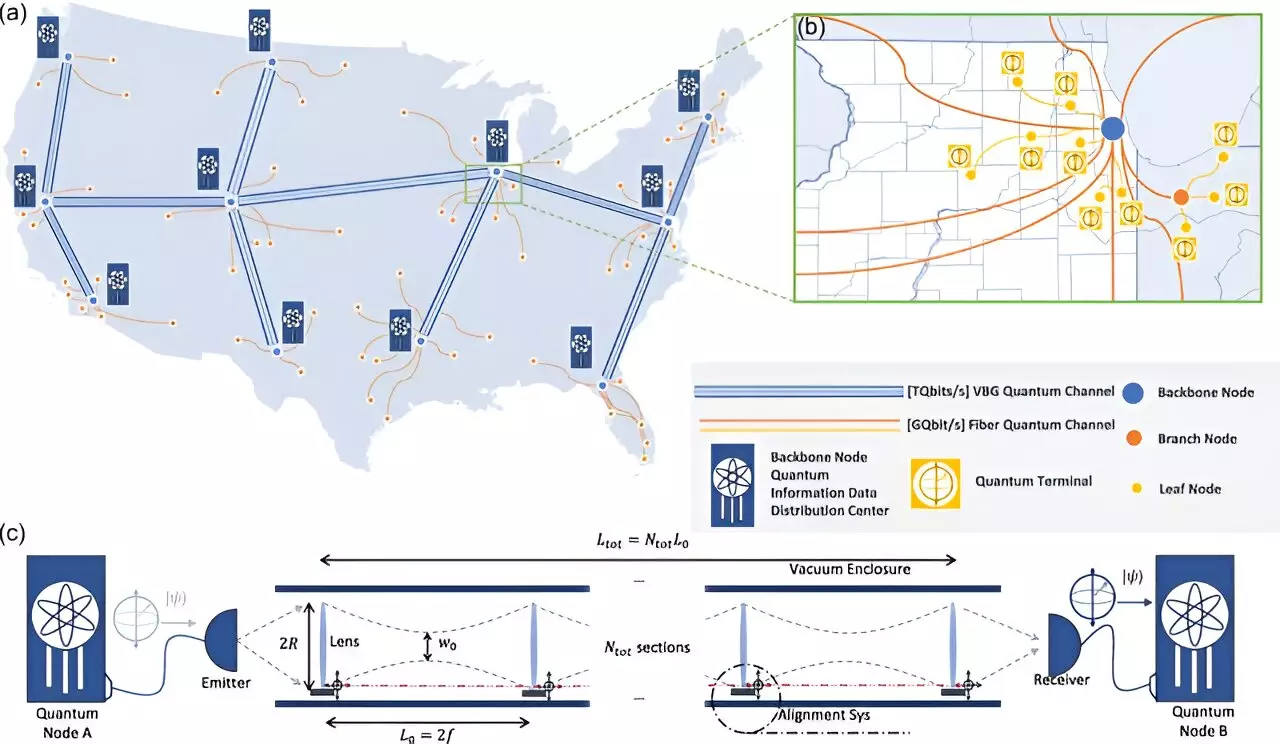Quantum computing is on the verge of revolutionizing the global technological landscape, transforming sectors ranging from cybersecurity to advanced data processing. Yet, the true potential of these cutting-edge machines may only be unlocked when they are interconnected, forming a sophisticated quantum internet. Let’s delve into the groundbreaking research emerging from the University of Chicago, where scientists have put forth a novel approach to creating long-distance quantum networks using ingeniously designed vacuum tubes and lenses.
The primary objective is clear: to transmit quantum information securely over vast distances. The approach hinges on the use of vacuum-sealed tubes approximately 20 centimeters in diameter, designed to facilitate the travel of light particles, or photons, that carry encoded quantum data. A team from the University of Chicago Pritzker School of Molecular Engineering, including lead researcher Liang Jiang, believes that this innovative design could support extensive data transfer with an astounding capacity of over 10 trillion qubits per second—marking a significant leap from existing quantum communication methods.
The Quantum Advantage and Its Challenges
In contrast to traditional computers that operate using bits represented by binary 0s and 1s, quantum computers employ qubits. These qubits possess properties such as superposition and entanglement, enabling them to perform computation at an unprecedented scale. The advantage comes with a challenge: establishing reliable communication networks that can maintain the unique quantum properties of these qubits.
Liang Jiang underscores a crucial point, noting, “You can’t send a quantum state over a classical network.” This statement encapsulates the dilemma faced by researchers striving to integrate quantum computing capabilities with existing network infrastructures. Classic networks lack the ability to sustain the quantum phenomena that render qubit processing so powerful.
Current attempts to bridge this gap have explored transmitting quantum information via fiber-optic cables or via satellites. Both strategies come with inherent limitations. While fiber-optic cables enable some data transmission, they frequently absorb photons, leading to the rapid degradation of quantum information. Satellite communication, conversely, benefits from the vacuum of space, which reduces absorption but is subject to atmospheric limitations and satellite availability. It’s evident that a more robust solution is required.
A New Paradigm: Harnessing the Vacuum
Inspired by initiatives at the Laser Interferometer Gravitational-Wave Observatory (LIGO), which has successfully employed gigantic vacuum tubes to detect gravitational waves, Jiang and his team have proposed a practical method for advancing quantum communications. The premise revolves around using smaller vacuum tubes on terrestrial grounds to facilitate long-distance photon transmission.
The proposed vacuum channels could transmit photons over thousands of kilometers with minimal interference. As the photons travel, they are susceptible to spreading out, posing a challenge for data integrity. To combat this, the involvement of strategically placed lenses every few kilometers is suggested. These lenses would refocus the beams, thus mitigating diffraction loss and maintaining the quantum characteristics of the photons. The implications of this enhancement are noteworthy, with Jiang stating, “We believe this kind of network is feasible and has a lot of potential.”
Collaboration and Progress: A Forward Momentum
The collaboration between researchers across institutions amplifies the credibility of this proposal. With educational powerhouses such as Stanford University and the California Institute of Technology involved, the path towards implementing this technology is both collaborative and multifaceted. Future experimental plans include smaller-scale tests, followed by the application of larger vacuum systems like those developed at LIGO, offering real-world opportunities to refine photonic alignment and stability.
However, transitioning from theoretical models to practical applications will encompass engineering hurdles. Jiang mentions that embedding such systems at a larger scale will necessitate addressing various civil engineering challenges, indicating a need for innovative engineering solutions alongside quantum technological advancements.
The Road Ahead: Opportunities Beyond Communication
This visionary research not only promises enhanced quantum communication but opens the door to a myriad of applications. Beyond secure communication networks, the implications extend to distributed quantum computing, advanced quantum sensing technologies, and even new astronomical tools like synchronized telescopes. The potential for various scientific explorations and technological innovations is astronomically high.
The remarkable synergy of quantum mechanics and engineering ingenuity embodies a critical milestone in the quest for interconnected quantum systems. As scientists continue to refine and prototype this vacuum tube network, we stand at the cusp of a transformative era that could redefine how we understand connectivity and computational power. The exploration of this uncharted territory will captivate not just scientists, but anyone intrigued by the concept of future technology and its vast possibilities.


Leave a Reply